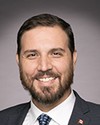Thank you for the opportunity to provide this committee and Canadians with the facts about our Data for Good program.
Telus launched Data for Good in April 2020 because we believed, as we still do, that our company's responsible use of data can play an impactful role in making more evidence-based and informed decisions. We created Data for Good to provide de-identified—that is, essentially anonymous—data to assist governments and health authorities in their efforts to stem the spread of COVID-19 and better understand the impact of interventions like restrictions and stay-at-home orders.
Data for Good was a natural extension of Telus's broader commitment to using our technology to enable social good in support of Canadians and the communities in which we live and work.
As you heard from Dr. Tam, the Data for Good program provided critical insights that supported more informed policies. In short, it worked.
I want to make one thing perfectly clear, Telus did not share any personal information with government—not one iota. Telus always puts its customers and their privacy first. At no time have we ever relaxed any of our rigorous policies about our treatment of personal information, including when we launched Data for Good during the pandemic.
The Data for Good program operates on a data analytics platform called Telus Insights, which is the only privacy-by-design certified platform of its kind in Canada. This platform uses de-identified datasets to reveal movement trends and patterns while protecting individual privacy. Under the Data for Good program, we allow data scientists from our partners, including the government, to have supervised and guided access to our secure Insights platform, which contains only de-identified datasets from our mobility network. Those datasets never left our systems. The data of our customers, even de-identified data, was not sent to the government.
I want to pause on privacy by design. That Telus Insights is privacy-by-design certified is important. Privacy by design is the international gold standard for privacy protection. It was developed here in Canada by Dr. Ann Cavoukian. Privacy by design goes beyond the requirements of the law to entrench privacy protections into the design and operation of the IT systems, networks and business practices of an organization.
With this certification, our Data for Good program is independently validated as being rigorous in its privacy protections. You also heard Dr. Cavoukian's endorsement of our approach last week.
We have taken a leading role nationally on the development and promotion of de-identification as a critical process to enhance privacy protections. Telus is a founding member of CANON, the Canadian Anonymization Network, whose mission is to promote effective de-identification practices and includes the leading Canadian de-identification experts.
Our commitment to de-identification is at the core of Telus Insights. Thanks to our privacy-first approach, Telus was able to leverage our Insights platform to provide pandemic assistance through Data for Good while fully protecting the privacy of customers. While some may compromise on privacy during a public health emergency, we did not. We are very proud of Data for Good and we were intentional and explicit in our public communication about the program.
We developed and published on our website five core data use commitments on how we would share de-identified data and protect privacy. These accompanied a full description of our program along with an FAQ. We had a banner on the main Telus website that linked to this information. Before and after launching the program, we did op-eds and interviews with The Globe and Mail and other Canadian media outlets and published news releases announcing new collaborations. We later publicized that Data for Good was awarded the International Association of Privacy Professionals Privacy Innovation Award in November 2020.
Apart from our public-facing communications about Data for Good and Insights, we consulted with the Office of the Privacy Commissioner of Canada on our transparency plan. We provided that office with an overview of our program, including the five core commitments. The OPC provided valuable feedback, which we gratefully incorporated.
The final point I'd like to make is that as part of our effort to go beyond simple compliance with the law, we offer our customers the ability to opt out of our data analytics program. We see this as a reflection of our customer-first commitment.
In closing, I want to reiterate that Telus provided access to this de-identified data for the public good. The data contained no personal information, so the privacy of our customers was respected, and we made great efforts to be transparent about the program. All of this is consistent with Telus's long-standing track record of protecting our customers' privacy.
Thank you again for the opportunity to speak with you today. I'd be pleased to answer your questions.




